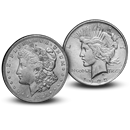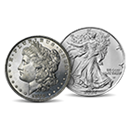
About U.S. Mint Silver
The United States Mint produces a variety of silver products, including silver coins and silver bullion.Silver Coins: The U.S. Mint is famous for producing various silver coins, some of which are part of ongoing series. The most notable silver coin series include:
- American Silver Eagle: Introduced in 1986, the American Silver Eagle is one of the most popular silver coins in the world. It contains one troy ounce of .999 fine silver and features Adolph A. Weinman's "Walking Liberty" design on the obverse and a heraldic eagle on the reverse.
- America the Beautiful Quarters: As part of this series, the U.S. Mint releases silver quarters with designs showcasing national parks and other national sites in the United States. These coins have a composition of 90% silver and 10% copper.
- First Spouse Gold Coins: Although these coins are primarily made of gold, they include a half-ounce silver medal as part of the packaging.
Silver Bullion: The U.S. Mint also produces silver bullion coins that are not intended for general circulation but are instead purchased by investors and collectors for their precious metal content. Silver prices are largely determined by the spot price. Apart from the American Silver Eagle mentioned above, there are other bullion coins released under various programs.
- America the Beautiful Silver Bullion Coins: These coins have the same designs as the America the Beautiful Quarters but are much larger, containing 5 troy ounces of .999 fine silver.
- American Innovation $1 Coin Program: This program includes silver dollar coins featuring innovations and inventors from various states. The coins have a composition of 99.9% silver.
History Of The U.S. Mint
Early History (1792-1836): The United States Mint traces its origins back to the Coinage Act of 1792, a pivotal moment in American history. On April 2, 1792, President George Washington signed the act into law, officially establishing the U.S. Mint in Philadelphia as the nation's first minting facility. As Philadelphia was the capital of the United States at the time, it became the natural choice for the main mint. The primary purpose of the Mint was to produce and regulate the coinage of the United States. Under this act, the Mint began producing various denominations of coins, including the copper half-cent and one-cent, as well as silver and gold coins like the silver dollar and gold eagle.Expansion and New Facilities (1835-1933): As the country expanded and new sources of precious metals were discovered in different regions, the need for additional minting facilities became apparent. To facilitate coin production closer to the areas where gold and silver deposits were found, several branch mints were established. The first branch mints included the Charlotte Mint in North Carolina, the Dahlonega Mint in Georgia, and the New Orleans Mint in Louisiana. However, during the Civil War, some of the branch mints were seized by the Confederacy, leading to a temporary disruption in coin production.
During the early 20th century, significant changes occurred in the U.S. Mint's operations. In 1933, President Franklin D. Roosevelt issued an executive order suspending the production of gold coins and effectively took the United States off the gold standard. As a result, gold coins were no longer in circulation, and many gold coins were recalled and melted down. The U.S. Mint shifted its focus to producing coins for regular currency use, adopting a clad composition for dimes and quarters in 1965, consisting of an outer layer of copper-nickel over a core of copper. Silver dollars for circulation were discontinued in 1935, though commemorative silver dollars were occasionally produced.
Modern Era and Current Operations (1934-present): In the aftermath of the Gold Recall of 1933, the U.S. Mint adjusted its operations and continued to play a vital role in producing coins for everyday transactions. Over the years, the Mint adapted to changing technologies and demands. Additional minting facilities were established across the country, including in San Francisco, Denver, West Point, and Fort Knox. These facilities expanded the Mint's capacity to meet the nation's coinage needs.
The U.S. Mint also diversified its offerings, producing a wide range of numismatic and collectible coins. This included special editions, proof sets, and commemorative coins, catering to the interests of collectors and investors alike. Today, the U.S. Mint remains an integral part of the nation's financial system, responsible for producing coinage and related products that play an essential role in the economy while preserving the country's numismatic heritage.
Learn More About Precious Metals
Buying Precious Metals doesn’t have to be intimidating. Whether you are making a long-term investment or simply admire the beauty of Precious Metals, APMEX provides the tools to help you make the best choice for your portfolio.
See All Articles










